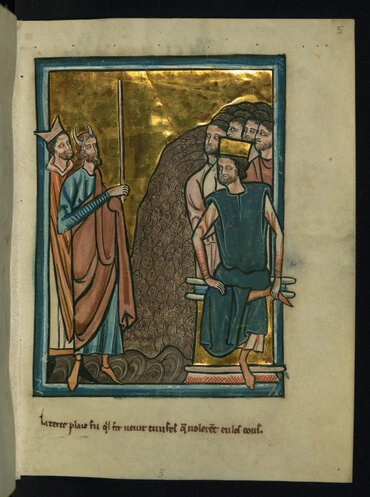Aaron

Aaron was the brother of Moses. He symbolizes two things, at different stages of the story.
During the first part of the exodus, when he was Moses' spokesperson, Moses represents the Word as it truly is, as it is understood in heaven, while Aaron represents the Word in its external sense, as it is understood by people in the world. This is why Aaron talks for Moses, and the Lord says of him "he shall be as a mouth for you, and you shall be to him as God." (Exodus 4:16)
Later, after the Tabernacle was built and he was inaugurated as high priest (see Leviticus 8,9), Aaron represents the Lord as to the Divine Good, and Moses represents the Lord as to the Divine Truth.
In Exodus 28:1, Aaron signifies the conjunction of Divine Good with Divine Truth in the Divine Human of the Lord. (Arcana Coelestia 9806, 9936)
In Exodus 32:1, Aaron represents the external of the Word, of the church, and of worship, separate from the internal. (Arcana Coelestia 10397)
In Exodus 4:14, before he was initiated into the priesthood, Aaron represents the doctrine of good and truth. (Arcana Coelestia 6998)
Arcana Coelestia # 5686
5686. 'His brother, his mother's son' means the internal born from the natural as its mother. This is clear from the representation of Benjamin, to whom 'brother' and 'mother's son' refer here, as the internal, dealt with in 5469. And since this is the intermediary it comes into being from the celestial of the spiritual, represented by 'Joseph', as its father, and from the natural as its mother; for it must have its beginning in both these if it is to serve as an intermediary. So this is what is meant by the internal born from the natural as its mother. Also because the celestial of the spiritual, which is 'Joseph', had come into being in a similar way from the natural as its mother, but from the Divine as its father, 'Benjamin' is therefore called, as he was in actual fact by birth, 'his brother, his mother's son'; and in what immediately follows he is also addressed as 'son'. The name 'brother' is used by the Lord, who is meant here in the highest sense by 'Joseph', to refer to everyone who has any good of charity which he has received from the Lord. He is also referred to as 'his mother's son', but in this case 'mother' is used to mean the Church.






